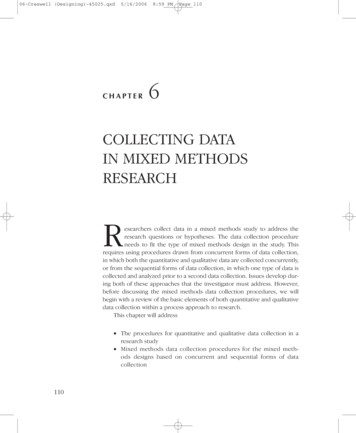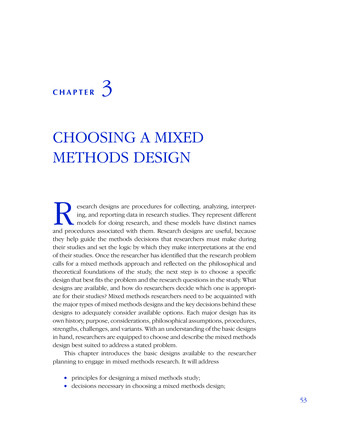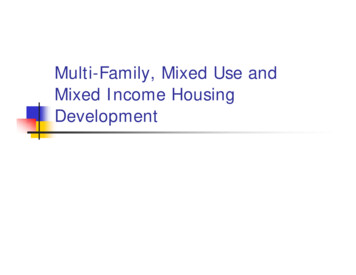
Transcription
06-Creswell (Designing)-45025.qxd5/16/2006CHAPTER8:59 PMPage 1106COLLECTING DATAIN MIXED METHODSRESEARCHResearchers collect data in a mixed methods study to address theresearch questions or hypotheses. The data collection procedureneeds to fit the type of mixed methods design in the study. Thisrequires using procedures drawn from concurrent forms of data collection,in which both the quantitative and qualitative data are collected concurrently,or from the sequential forms of data collection, in which one type of data iscollected and analyzed prior to a second data collection. Issues develop during both of these approaches that the investigator must address. However,before discussing the mixed methods data collection procedures, we willbegin with a review of the basic elements of both quantitative and qualitativedata collection within a process approach to research.This chapter will address The procedures for quantitative and qualitative data collection in aresearch study Mixed methods data collection procedures for the mixed methods designs based on concurrent and sequential forms of datacollection110
06-Creswell (Designing)-45025.qxd5/16/20068:59 PMPage 111Collecting Data in Mixed Methods Research– –111PROCEDURES IN QUALITATIVE ANDQUANTITATIVE DATA COLLECTIONWhen researchers think about data collection, they often turn to the specifictypes of data collection and the procedures for collecting that data. Webelieve that there are some phases to the process of data collection that,in combination, comprise the data collection step in research. As shown inTable 6.1, these phases are the sampling procedures, permissions, typesof information collected, forms for recording the data, and the activitiesinvolved in administering the data collection. Each phase will be discussedindividually for both qualitative and quantitative data collection as a reviewprior to discussing mixed methods data collection. The review is adaptedfrom several chapters in Creswell (2005a).Table 6.1Phases in the Data Collection Process for Qualitative and Quantitative ResearchQualitative Data CollectionPhases in the Processof ResearchQuantitative Data Collection Purposeful samplingstrategies Small number of participantsand sitesSampling Random sampling Adequate size to reducesampling error and providesufficient power From individuals providingaccess to sites Institutional review boards IndividualsPermissions From individuals providingaccess to sites Institutional review boards Individuals Data sources Instruments Checklists Public documents Interview protocols Observational protocolsRecording the data Instruments with scores that arereliable and valid Attending to field issues Attending to ethical issuesAdministering datacollection Standardization of procedures Attending to ethical issuesOpen-ended interviewsOpen-ended observationsDocumentsAudiovisual materials
06-Creswell (Designing)-45025.qxd5/16/20068:59 PMPage 112112– –DESIGNING AND CONDUCTING MIXED METHODS RESEARCHSampling ProceduresTo address a research question or hypothesis, the researcher decideswhich people and research sites can best provide information, puts a sampling procedure in place, and determines the number of individuals that willbe needed to provide data.In qualitative research, the inquirer purposefully selects individualsand sites that can provide the necessary information. Purposeful samplingmeans that researchers intentionally select participants who have experiencewith the central phenomenon or the key concept being explored. A numberof purposeful sampling strategies are available, each with a different purpose.One of the more popular is maximal variation sampling, in which individualsare chosen who hold different perspectives on the central phenomenon. Thecriteria for maximizing differences depends on the study, but it might berace, gender, level of schooling, or any number of factors that would differentiate participants. The central idea is that if participants are purposefullychosen to be different in the first place, then their views will reflect this difference and provide a good qualitative study. Another approach is to useextreme case sampling of individuals who provide unusual, troublesome, orenlightened cases. In contrast, a researcher might use homogeneous sampling of individuals who have membership in a subgroup with distinctivecharacteristics.In terms of numbers, rather than selecting a large number of people orsites, the qualitative researcher identifies a small number that will providein-depth information about each person or site. The larger the number ofpeople, the less the amount of detail typically emerging from any one individual—and a key idea of qualitative research is to provide detailed views ofindividuals and the specific contexts in which they hold these views. Manyqualitative researchers do not like to constrain research by giving definitivesizes of samples, but the numbers may range from one or two people, as ina narrative study, to 50 or 60 in a grounded theory project. Typically, whencases are reported, a small number is used, such as 4 to 10. The numberrelates to the question or to the type of qualitative approach used, such asnarrative, phenomenology, grounded theory, ethnography, or case studyresearch (Creswell, 1998).In quantitative research, the intent of sampling individuals is to chooseindividuals that are representative of a population so that the results can begeneralized to a population. In this way, investigators first select their population and define it carefully. Then they choose a sample from this population.Although not always workable, random choice of individuals for the sample isattempted so that each person in the population has an equal chance of being
06-Creswell (Designing)-45025.qxd5/16/20068:59 PMPage 113Collecting Data in Mixed Methods Research– –113selected. Probabilistic sampling involves randomly choosing individuals basedon a systematic procedure, such as the use of a random numbers table. Inaddition, the investigator may want certain characteristics represented in thesample that may be out of proportion in the larger population. For example,more females than males may be in the population, and a random sampling procedure would, logically, oversample females. In this situation, theresearcher first stratifies the population (e.g., females and males) and thenrandomly samples within each stratum. In this way, a proportional number ofparticipants on the stratification characteristic will be represented in the finalsample chosen for data collection.The sample size needed for a rigorous study is more specified in quantitative research. The sample needs to be large enough for statistical procedures to be used that will make it possible for the researcher to drawinferences with some confidence that the sample reflects the characteristicsof the entire population (if that entire population could be studied). We wantto reduce the sampling error: the difference between the sample estimateand the true population score. To determine the adequate sample size,researchers turn to sample size formulas available in research methods textbooks. If the quantitative research design is an experiment, investigators turnto power analysis formulas (e.g., Lipsey, 1990); if the study is a survey, sampling error formulas can help identify the appropriate size for the sample(e.g., Fowler, 1988).Permissions NeededResearchers require permission to collect data from individuals and sites.This permission can be gained at three levels: from individuals who are incharge of sites; from people providing the data (and their representatives,such as parents); from campus-based institutional review boards (IRBs); and,as part of the IRB process, from individuals who will actually provide data.Obtaining access to people and sites requires obtaining permissionsfrom individuals in charge of sites. Sometimes this involves individuals atdifferent levels, such as the hospital administrator, the medical director, andthe staff participating in the study. These levels of permissions are requiredregardless of whether the study is qualitative or quantitative. However,because qualitative data collection involves spending time at sites, and thesites may be places not typically visited by the public (e.g., soup kitchens forthe homeless), researchers need to find a gatekeeper, an individual in theorganization supportive of the proposed research who will, essentially, “openup” the organization. Qualitative research is well known for the collaborative
06-Creswell (Designing)-45025.qxd5/16/20068:59 PMPage 114114– –DESIGNING AND CONDUCTING MIXED METHODS RESEARCHstance of its researchers, who seek to involve participants in many aspectsof research. The opening up of an organization may also be necessary forquantitative studies in hard-to-visit organizations, such as the FBI or othergovernmental agencies.To conduct research sponsored by a university or college, researchers mustseek and obtain permission from campus-based IRBs. These boards have beenestablished to protect the rights of individuals participating in research studiesand to assess the risk and potential harm of the research to these individuals.Researchers need to obtain the permission of the appropriate board and guarantee that the rights of participants will be protected. Failure to do so can havenegative consequences for the university or college, such as withdrawal offederal funds. Typically, obtaining permission from an IRB involves filing anapplication, presenting information about the level of risk and harm, and guaranteeing that rights will be protected. The researcher guarantees protection ofrights by stating them in writing and having the participants (or a responsibleadult, if the participant is a minor) sign a form (i.e., a consent form) before theyprovide data. Researchers may not present or publish their findings ifpermissions were not obtained before the start of the data collection.In qualitative research, procedures need to be stated in detail, becausethe research often involves asking personal questions and collecting datain places where individuals live or work. The information collected fromobserving families at home, for example, may place individuals at particularrisk. When behaviors are videotaped, participants are at risk of havingunwanted behaviors disclosed. In quantitative research, individuals need toprovide the researcher with permission to complete instruments or havetheir behavior observed and checked off. Often this research does not takeplace in the individuals’ homes or workplaces, and it is less obtrusive and lesslikely to put individuals at risk of harm.Information to Be CollectedResearchers need to consider the types of data that are possible andexamine and weigh each option so they can determine what sources ofdata will best answer the research questions or hypotheses. In qualitativeresearch, the types of data available are much more extensive than in quantitative research. Qualitative types of data might be categorized in terms oftheir sources: as open-ended interviews, open-ended observations, documents (private and public), and audiovisual materials (e.g., videotapes, photographs, sounds). These options represent data in the form of text orimages, and the possibilities continue to expand into new forms, such as text
06-Creswell (Designing)-45025.qxd5/16/20068:59 PMPage 115Collecting Data in Mixed Methods Research– –115messaging, e-mails, and videotape elicitation. At least 25 different approachesexist (Creswell, 2005a).In quantitative research, the forms of data have been reasonably stableover the years. Investigators collect quantitative data using instruments thatmeasure individual performance (e.g., aptitude tests) or individual attitudes(e.g., attitudes toward self-esteem scales). They also gather structured interview and observational data in which the response categories are determinedbefore the data collection in a closed-ended fashion. They collect factualinformation in the form of numbers from census data, attendance reports,and progress summaries. Again, as with the forms of qualitative data, researchers need to assess which options will best address their research questions orhypotheses.Recording the DataThe approach we take to data collection involves systematically gathering information and recording it in such a way that it can be preserved andanalyzed by a single researcher or a team of researchers. For qualitative datacollection, forms for recording the information need to be developed. Ifinterview data are collected, then an interview protocol is needed that notonly lists the questions and provides space in which to record answers butalso has a place for essential data about the time, day, and place of the interview. In many cases, the researcher audiotapes the qualitative interviews andlater transcribes the interviews. Having an interview protocol helps keep theresearcher organized, and it provides a record of information in the eventthat the recording devices do not work. An observational protocol also provides a useful way of organizing an observation. On this form, the researcherrecords a description of events and processes observed, as well as reflectivenotes about emerging codes, themes, and concerns that arise during theobservation. Recording forms can also be developed for reviewing documents and for recording image data, such as photographs.In quantitative research, the investigator selects an instrument to use ordevelops an instrument. This instrument may be an attitudinal scale, withscores of past use showing high reliability and validity. It might be a reliableand valid checklist based on past scores. For documents with numeric data,the researcher often composes a form that summarizes the data. In choosingan instrument or a checklist, the researcher is concerned about the validityand reliability of past scores, whether the questions fit the research questionsand hypotheses in the study, and whether adequate scales are used to reportthe information.
06-Creswell (Designing)-45025.qxd5/16/20068:59 PMPage 116116– –DESIGNING AND CONDUCTING MIXED METHODS RESEARCHAdministering the Data CollectionAdministering the data collecting involves the procedures for gatheringthe data. In qualitative research, much discussion in the literature is directedtoward reviewing and anticipating the types of issues likely to arise “in thefield” that will yield less-than-adequate data. Issues such as the time to recruitparticipants, the researcher’s role in observing, the adequate performance ofrecording equipment, the time to locate documents, and the details of theproper placement of videotaping equipment illustrate the types of concernsthat need to be addressed. Also, the researcher needs to enter sites in a waythat is respectful and does not disrupt the flow of activities. Ethical issues,such as providing reciprocity to participants for their willingness to providedata, handling sensitive information, and disclosing the purposes of theresearch, apply to both qualitative and quantitative research.Administering the data collection in quantitative research involvesattending to these ethical issues. In addition, the procedures of data collection need to be administered with as little variation as possible so that bias isnot introduced into the process. Standardized procedures should exist forcollecting data on instruments, on checklists, and from public documents. Ifmore than one investigator is involved in data collection, training should beprovided so that the procedure is administered in a standard way each time. DATA COLLECTION IN MIXED METHODS DESIGNSIt is essential to know the general procedures of collecting data in qualitativeand quantitative research because mixed methods research involves collectingboth forms of data. Before we turn to specific designs, here are several generalguidelines for collecting both forms of data in mixed methods research: The data collection procedures will vary depending on the type ofmixed methods design. A helpful way to conceptualize data collectionamong the designs is to consider data collection as occurring concurrently or sequentially. In concurrent data collection, the quantitativeand qualitative data are collected at roughly the same time (as in theTriangulation and Embedded Designs). In the sequential approach,the quantitative (or qualitative) data is collected first, and the resultsinform the second (quantitative or qualitative) form of data collection(as in the Explanatory, Exploratory, and Embedded Designs). When data are collected concurrently, the two forms (quantitative andqualitative) of data are independent of each other; when collectedsequentially, the two forms of data are related or connected.
06-Creswell (Designing)-45025.qxd5/16/20068:59 PMPage 117Collecting Data in Mixed Methods Research– –117 Regardless of the concurrent or sequential or independent orconnected forms of data collection, use rigorous quantitative andqualitative procedures, as discussed earlier in this chapter. IRB permissions are required for all research data collection. In theconcurrent approaches, both forms of data collection can bedescribed at the outset; in the sequential forms, only the initial phaseof data collection can be identified with any certainty. Because IRBreview boards require as full a disclosure of data collection procedures as possible, in the sequential forms of data collection, state thefollow-up phase as tentative, recognizing that an addendum may needto be filed with the IRB when the follow-up data collection proceduresare firmly established.Concurrent Data Collection IssuesA concurrent form of data collection exists for the Triangulation Design(and its variants) and the Embedded Design with concurrent data collection(see Chapter 4).Figure 6.1 shows the general process for data collection in which the twotypes of data are collected concurrently. Not only are the data collected during the same timeframe and independent of each other, they may be collected from the same level inan organization or from different levels. In the multilevel variant of theTriangulation Design, the quantitative and qualitative data collectionoccur at different levels (or with different units of analysis). In a mixedmethods study of the efficacy of using student cotherapy teams inmarriage and family therapy programs, Hendrix, Fournier, and Briggs(2001) gathered quantitative data from clients on their outcomes (402cases) and qualitative data from 12 therapists on their experiences. In addition, quantitative and qualitative data collection can be givenequal or unequal weight in a study. An Embedded Design incorporatingqualitative data into an intervention trial in the health sciences illustrates a lesser priority for the qualitative data collection. An exampleof this design is found in a study of breath therapy for patients withchronic low-back pain (Meling, Hamel, Acree, Byl, & Hecht, 2005). Inthis randomized, controlled trial, the investigators examined the outcomes of reduced pain, physical and emotional roles, and vitality. Theinvestigators were also curious about how the patients experienced thetreatments from breath therapists, and they asked the patients to reportqualitative data in diary entries about their treatment experiences.
06-Creswell (Designing)-45025.qxd5/16/20068:59 PMPage 118118– –DESIGNING AND CONDUCTING MIXED METHODS RESEARCHQUAN/quandata collection Data collected at sametime Independent of each other Same level (TriangulationConvergence Design) ordifferent levels(Triangulation MultilevelDesign) Given equal (TriangulationConvergence) or unequalpriority (Embedded Design,Triangulation ValidatingQuantitative Design)QUAL/qualdata collectionQUAN/quandata analysisAnalyzed for DifferentPurposes: convergefindings, validate otherform of data, transformedfor comparisons, analyzedfor different types of questionsQUAL/qualdata analysisFigure 6.1Concurrent Forms of Mixed Methods Data Collection In concurrent forms of data collection, the analysis is conducted fordifferent purposes: to converge the findings (in the TriangulationConvergence Design); to validate one form of data (typically quantitative) through the other forms (typically qualitative data) (in theTriangulation Validating Quantitative Data Design); to transform thedata for comparison (in the Triangulation Data Transformation Design);or to generate data that will address different types of questions (inthe Embedded Experimental or Correlational Design). Procedures foranalyzing the data will be examined further in Chapter 7.Despite these general characteristics, specific issues arise in using a concurrent form of data collection.
06-Creswell (Designing)-45025.qxd5/16/20068:59 PMPage 119Collecting Data in Mixed Methods Research– –119Participant Selection. Should the same or different individuals be selectedfor the quantitative and qualitative samples? A clear consensus does not existon this question, but a common practice among mixed methods researchersis to select the same individuals for both the quantitative and qualitative datacollection, so the data can be more easily converged or compared. Selectingdifferent individuals will introduce personal characteristics that might confound the comparison.There are ample illustrations of the use of the same individuals orsites in the Triangulation and Embedded Designs. In a convergence study ofteacher candidates’ multicultural attitudes and knowledge, Capella-Santana(2003) gathered quantitative questionnaire data from 90 undergraduate elementary education teacher candidates. She also invited all 90 participants tobe interviewed “to corroborate the information obtained through the questionnaires” (p. 185). McVea et al. (1996) evaluated family practices that hadadopted prevention materials in another Triangulation Convergence Design.They gathered both quantitative data (e.g., using a structured observationchecklist) and qualitative data (e.g., through key informant interviews) fromthe same eight practices. In an Embedded Intervention Design, Whittemore,Rankin, Callahan, Leder, and Carroll (2000) studied how social support frompeer advisors decreased complications following myocardial infarction. Theyconducted a randomized controlled trial and had peer advisors provide socialsupport to the patients. Their qualitative data collection within this trialinvolved collecting data from the peer advisors during the trial.The Sample Size Question. Should the same number of individuals be sampled for both the quantitative and the qualitative arms of the data collection?The standard answer to this question is that the size of the quantitativesample (preferably randomly selected) will not be the same size as thesmaller (preferably purposefully selected) qualitative sample. This disparity, ofcourse, raises the question of how to converge or compare the two databasesin any meaningful way. In the Embedded Designs, it is assumed that theembedded data will play a secondary role and be supplemental to theprimary dataset. Also, the embedded data typically answer a different question (e.g., what did the patients experience during the treatment?) thanthe primary data (e.g., did the treatment influence the outcomes?). For aTriangulation Design, the question of sample size is more relevant, despitethe lack of attention to this issue in the mixed methods literature. A typicalapproach to this problem is to increase the qualitative list of participants and,in doing so, sacrifice some of the detail elicited from individuals. In Luzzo’s(1995) Triangulation Convergence Design, his quantitative sample consisted
06-Creswell (Designing)-45025.qxd5/16/20068:59 PMPage 120120– –DESIGNING AND CONDUCTING MIXED METHODS RESEARCHof 401 students and his qualitative sample, 128 of that 401 students, a largenumber for interviews or for establishing any depth of detail from any singlestudent. Another approach would be to weight the qualitative cases so thatthe information can be compared with the same number of quantitativecases. A final approach is to state that the comparison of the two databasesis limited because of the discrepancy in size.When Contradictory Results Occur. In the Triangulation Convergence Design,the results of the quantitative analysis and the qualitative findings may becontradictory. How does the researcher proceed? An approach suggested inthe mixed methods literature (Creswell, 2003) is for the researcher to gatheradditional data to help resolve the contradiction.Should the additional data be quantitative data or qualitative data? Aclear answer does not exist to this question. However, the usual solution isto present the two findings in parallel and state that more research is needed(Padgett, 2004). Another approach is to collect more data to resolve the contradiction, an approach that may or may not be feasible and timely. Researchcould also view the problem as a springboard for new directions of inquiry(Bryman, 1988).Padgett’s (2004) study recounts how a team of researchers returnedto their initial database as a springboard for more insights. This emergedduring the Harlem Mammogram Study, which was funded by the NationalCancer Institute to examine factors that influenced delay in response to anabnormal mammogram among African American women living in New YorkCity. The research team Padgett was on had collected both structured quantitative data and open-ended interview data. After data analyses, the teamconcluded that the women’s decisions to delay were not driven by factors intheir quantitative model. The researchers then turned to their qualitativedata, highlighted two qualitative themes, and reexamined their quantitativedatabase for support for the themes. To their surprise, the quantitative dataconfirmed what the participants had said. This new information, in turn, ledto a further exploration of the literature, in which they found some confirmation for the new findings.Introducing Potential Bias Through Data Collection. If data are collectedconcurrently, will one form of data bias the other? In all of the concurrent datacollection procedures, it is possible that one form of data might introducebias that would confound the results from the other form of data if collectedfrom the same participants. Researchers need to be alert to this possibility andopenly discuss it. Steps should be taken to minimize this potential bias. Biascan be a problem in intervention trials in which the investigators introduce a
06-Creswell (Designing)-45025.qxd5/16/20068:59 PMPage 121Collecting Data in Mixed Methods Research– –121qualitative arm during the trial. One solution to this issue is to collect unobtrusive qualitative data. This was the approach used by Victor et al. (2004) inan intervention trial of individuals with osteoarthritis of the knee. They askedindividuals in the intervention group to maintain diaries during the intervention to review their symptoms, use of medication, and goals for treatmentduring the trial. The investigators then collected these diaries after the intervention and reviewed them. Another approach is to equally distribute thequalitative data collection across all treatment and control groups. Finally,investigators might postpone the qualitative data collection until after theintervention and employ a sequential design of data collection.Sequential Data Collection IssuesSequential data collection involves different procedures than concurrentdata collection. Several guidelines apply to the sequential approach to datacollection: Sequential data collection involves collecting the data in stages: Onedata collection is followed by a second data collection. These procedures are included in the Explanatory and the Exploratory Designs, aswell as the sequential forms of the Embedded Design. In this type of data collection, the quantitative and qualitative datacollections are related to each other and not independent. One buildson the other. Either the first or second data collection may be weighted more heavily, and the top priority data collection may be either qualitative orquantitative. It depends on the research problem and the approachthe investigator wants to emphasize. As shown in Figure 6.2, sequential data collection is conceptualizedas having three stages. In the first stage, the data collection and analysis are either qualitative (for the Exploratory Design) or quantitative(for the Explanatory Design). Either approach could be used in anEmbedded Design. Decisions are made in Stage 2 about how theresults will be used to influence the Stage 3 data collection and analysis. Figure 6.2’s Stage 2 section shows how Stage 1 results are used differently in Explanatory, Exploratory, and Embedded Designs. Stage 3then involves a second data collection and analysis of data. In thisapproach, the final Stage 3 data collection and results build on the initial Stage 1 results. Thus, Stage 2 is inserted into the process betweenthe two data collections.
06-Creswell (Designing)-45025.qxd5/16/20068:59 PMPage 122122– –DESIGNING AND CONDUCTING MIXED METHODS RESEARCHStage 1Stage 2Stage 3How will Stage 1results be used inStage 3?Data collectionQUAL or QUANData analysisQUAL or QUANFigure 6.2 Further explained(Explanatory Followup Design, EmbeddedDesign) To select participants(ExplanatoryParticipant SelectionDesign, ExploratoryTaxonomy Design) To develop and testan instrument(ExploratoryInstrumentDevelopment Design) To develop andtest a taxonomy(ExploratoryTaxonomyDevelopment Design) To develop anintervention(Embedded Design)Data Collectionquan or qualData analysisquan or qualSequential Forms of Mixed Methods Data CollectionAs in the concurrent procedures, sequential data collection involvesseveral issues.Sampling the Same or Different Individuals. Should the same
The data collection procedure needs to fit the type of mixed methods design in the study. This requires using procedures drawn from concurrent forms of data collection, in which both the quantitative and qualitative data are collected concurrently, or from the sequential forms of data collection, in which one type of data is collected and analyzed prior to a second data collection. Issues .









